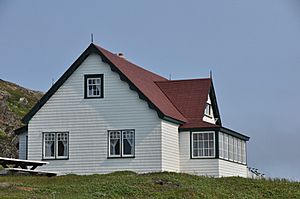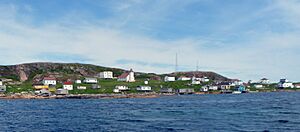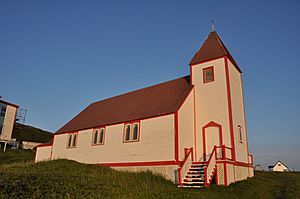Battle Harbour facts for kids
Battle Harbour (Inuttitut: Putlavak) is a historic fishing spot in Labrador, Canada. It used to be a busy town, but now it's mainly used in the summer. For about 200 years, Battle Harbour was the main hub for business and community life on the southeastern Labrador coast.
In the 1770s, people started drying and salting fish here. This grew into a lively community, even called the Capital of Labrador. But things changed when there were fewer cod fish to catch. A big fire in 1930 also caused a lot of damage. In the 1960s, the government helped people move away, and Battle Harbour was no longer a permanent home.
Today, the Battle Harbour Historic Trust looks after the old fishing buildings and other properties. They have turned the area into a museum. It helps us remember what life was like for people in Newfoundland and Labrador during the 1700s, 1800s, and 1900s. Battle Harbour is now a National Historic Site. This means it's a very important place in Canadian history.
Contents
Exploring Battle Harbour's Location
Battle Harbour is found on Battle Island. It faces a calm, narrow waterway that separates it from Great Caribou Island. Some people think the name "Battle Harbour" comes from the Portuguese word batel, which means "boat." This word appeared on old Portuguese maps around 1560. The Inuit people, who lived in this part of Labrador, also called Battle Harbour Ca-tuc-to.
The waterfront was always a very busy place. Fishers would bring their catches here, including cod, salmon, seals, and herring. Workers would process the fish, make barrels, and pack the fish products. They also mended nets and prepared salted fish. The flake, which is a platform for drying fish, was the largest in all of Labrador. The Salt Store, a big warehouse for salt, could hold up to 1,500 tons! The buildings you see today have been rebuilt. They remind us of how things used to be and hold many old fishing tools and items.
The Battle Harbour Historic District was named a National Historic Site in 1996. The amazing ocean views and rocky cliffs create a beautiful background for the small wooden church and houses. The main part of Battle Harbour is the wharf and the buildings along the water. These old, wooden buildings were built by English and Newfoundland merchants in the late 1700s and 1800s.
What's the Weather Like?
Battle Harbour has a cold and humid climate all year round. This is because it's in eastern Labrador and is affected by the Labrador Sea. The Labrador Current also makes it very cold.
The average temperature throughout the year is about 0.3 degrees Celsius. August is usually the warmest month, reaching around 10.9 degrees Celsius. January is the coldest, with temperatures around -10.5 degrees Celsius. Battle Harbour gets about 953.3 millimeters of rain and snow each year. March is the wettest month, and May is the driest. The highest temperature ever recorded was 29.5 degrees Celsius on July 3, 1981. The lowest was -34.0 degrees Celsius on January 13, 1978.
A Look Back at Battle Harbour's Past
The first fishing businesses at Battle Harbour were started by a company from England called John Slade and Company in the early 1770s. Battle Harbour was like a gateway for Newfoundlanders who wanted to fish in the rich waters of Labrador. More people moved here after 1820. This was when fishing schooners from Newfoundland started using Battle Harbour as their main stop. It became known as the capital of the Labrador floater fishery.
Slade and Co. owned Battle Harbour until 1871. During this time, it grew into a settled community. Fish merchants were very powerful, but the town also developed its own schools and churches. In 1871, Slade and Co. sold Battle Harbour to Baine, Johnston and Company Ltd. This company ran the site in a similar way until 1955. The story of these two companies at Battle Harbour shows us a lot about the history of fishing in Newfoundland and Labrador for almost 200 years.
In 1955, Baine, Johnston and Company Ltd. sold the property to The Earle Freighting Service Ltd. They continued to operate the site until the inshore fishery declined in the early 1990s. At that point, the site was given to the Battle Harbour Historic Trust. Most permanent residents had already moved away between 1965 and 1970, as part of a government program. However, some families still use Battle Harbour as a summer home.

There's a legend that says the Montagnais Indians and the French fought their last battle against the Inuit around 1760 at Battle Harbour. Some people believe the name "Battle Harbour" comes from this event. A burial mound is said to mark the spot.
We don't know exactly when Europeans first settled in Battle Harbour. It's thought that the French didn't fish north of Cape Charles before 1718. Captain George Cartwright visited Battle Harbour in 1775. He wrote in his diary that a privateer (a type of pirate ship) had attacked Twillingate. Then, it "came to Battle Harbour on this coast and had taken a sloop of Mr. Slade's with about twenty-two tuns of seals' oil on board and destroyed his goods there."
In 1892, Dr. Wilfred Grenfell visited Battle Harbour. A year later, he built a hospital there. It was one of the first hospitals in Labrador. It opened in 1893 with a qualified doctor and nurse, offering service all year. In 1896, a new part was added to the hospital using wood from two wrecked ships.
In the fall of 1930, a terrible fire destroyed Battle Harbour. Dr. Grenfell said that "even the Marconi Pole on the top of the hill was burned." After the fire, the new school and hospital were rebuilt in Mary's Harbour.
How Battle Harbour Made a Living
In 1851, Bishop Edward Feild said that Battle Harbour was probably the oldest and largest settlement on the Labrador coast. The men who came and stayed there were usually from the Island of Newfoundland. They often brought workers from Dorset, England. Some of the first people to live there permanently were fishers, carpenters, and coopers (barrel makers) from Poole, Dorset, Fogo Island, and New World Island.
As the community grew, people needed more supplies. Merchants took advantage of this, and sometimes local residents paid twice the normal price for goods. This unfair system wasn't challenged until 1918. That's when Battle Harbour's first co-operative was started, thanks to Dr. Wilfred Grenfell. This co-op helped people get fairer prices.
In 1905, the first Newfoundland government lighthouse in Labrador, called Double Island Light, was built at Battle Harbour. In 1921, telegraph service was installed, making communication easier.
After the big fire in 1930 and a sharp decline in fishing in the 1950s, people started looking for jobs elsewhere. This led to the resettlement of Battle Harbour residents between 1965 and 1970. They moved to places like Mary's Harbour, Happy Valley, and Epworth as part of the Fisheries Household Resettlement Programme.
Since 1966, Battle Harbour has mainly been a summer fishing station. In 1980, it also became the site of a government weather station that operated all year round.
Community Life and Culture
In 1973, the St. John Ambulance started a very successful health care program at Battle Harbour. This program taught people in isolated communities how to take care of their own health and how to save lives. It became famous around the world and was used as a model in over thirty countries in Africa, the Caribbean, the South Pacific, and the Middle East.



